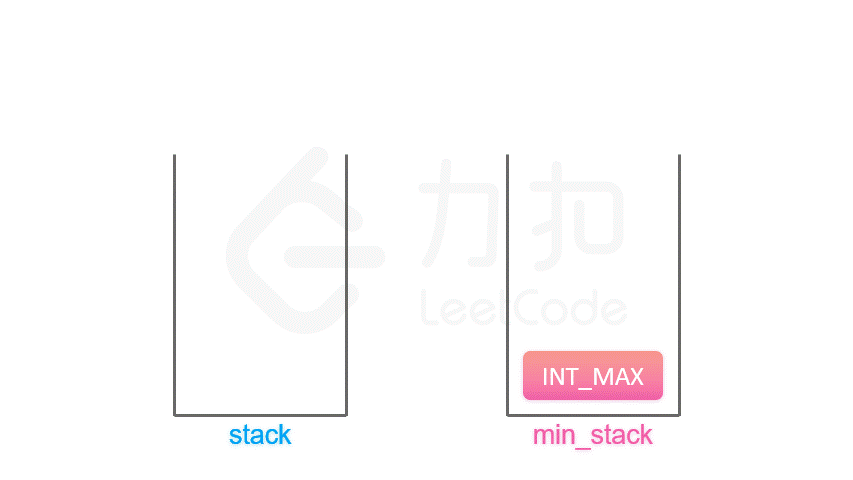设计一个支持 push ,pop ,top 操作,并能在常数时间内检索到最小元素的栈。
实现 MinStack 类:
MinStack() 初始化堆栈对象。void push(int val) 将元素val推入堆栈。void pop() 删除堆栈顶部的元素。int top() 获取堆栈顶部的元素。int getMin() 获取堆栈中的最小元素。
示例 1:
**输入:**
["MinStack","push","push","push","getMin","pop","top","getMin"]
[[],[-2],[0],[-3],[],[],[],[]]
**输出:**
[null,null,null,null,-3,null,0,-2]
**解释:**
MinStack minStack = new MinStack();
minStack.push(-2);
minStack.push(0);
minStack.push(-3);
minStack.getMin(); --> 返回 -3.
minStack.pop();
minStack.top(); --> 返回 0.
minStack.getMin(); --> 返回 -2.
提示:
-231 <= val <= 231 - 1pop、top 和 getMin 操作总是在 非空栈 上调用push, pop, top, and getMin最多被调用 3 * 104 次
📺视频题解

📖文字题解
方法一:辅助栈
思路
要做出这道题目,首先要理解栈结构先进后出的性质。
对于栈来说,如果一个元素 a 在入栈时,栈里有其它的元素 b, c, d,那么无论这个栈在之后经历了什么操作,只要 a 在栈中,b, c, d 就一定在栈中,因为在 a 被弹出之前,b, c, d 不会被弹出。
因此,在操作过程中的任意一个时刻,只要栈顶的元素是 a,那么我们就可以确定栈里面现在的元素一定是 a, b, c, d。
那么,我们可以在每个元素 a 入栈时把当前栈的最小值 m 存储起来。在这之后无论何时,如果栈顶元素是 a,我们就可以直接返回存储的最小值 m。

算法
按照上面的思路,我们只需要设计一个数据结构,使得每个元素 a 与其相应的最小值 m 时刻保持一一对应。因此我们可以使用一个辅助栈,与元素栈同步插入与删除,用于存储与每个元素对应的最小值。
当一个元素要入栈时,我们取当前辅助栈的栈顶存储的最小值,与当前元素比较得出最小值,将这个最小值插入辅助栈中;
当一个元素要出栈时,我们把辅助栈的栈顶元素也一并弹出;
在任意一个时刻,栈内元素的最小值就存储在辅助栈的栈顶元素中。
[sol1-Python3]1
2
3
4
5
6
7
8
9
10
11
12
13
14
15
16
17
18
| class MinStack:
def __init__(self):
self.stack = []
self.min_stack = [math.inf]
def push(self, x: int) -> None:
self.stack.append(x)
self.min_stack.append(min(x, self.min_stack[-1]))
def pop(self) -> None:
self.stack.pop()
self.min_stack.pop()
def top(self) -> int:
return self.stack[-1]
def getMin(self) -> int:
return self.min_stack[-1]
|
[sol1-C++]1
2
3
4
5
6
7
8
9
10
11
12
13
14
15
16
17
18
19
20
21
22
23
24
25
26
| class MinStack {
stack<int> x_stack;
stack<int> min_stack;
public:
MinStack() {
min_stack.push(INT_MAX);
}
void push(int x) {
x_stack.push(x);
min_stack.push(min(min_stack.top(), x));
}
void pop() {
x_stack.pop();
min_stack.pop();
}
int top() {
return x_stack.top();
}
int getMin() {
return min_stack.top();
}
};
|
[sol1-Java]1
2
3
4
5
6
7
8
9
10
11
12
13
14
15
16
17
18
19
20
21
22
23
24
25
26
27
28
| class MinStack {
Deque<Integer> xStack;
Deque<Integer> minStack;
public MinStack() {
xStack = new LinkedList<Integer>();
minStack = new LinkedList<Integer>();
minStack.push(Integer.MAX_VALUE);
}
public void push(int x) {
xStack.push(x);
minStack.push(Math.min(minStack.peek(), x));
}
public void pop() {
xStack.pop();
minStack.pop();
}
public int top() {
return xStack.peek();
}
public int getMin() {
return minStack.peek();
}
}
|
[sol1-JavaScript]1
2
3
4
5
6
7
8
9
10
11
12
13
14
15
16
17
18
19
20
21
22
| var MinStack = function() {
this.x_stack = [];
this.min_stack = [Infinity];
};
MinStack.prototype.push = function(x) {
this.x_stack.push(x);
this.min_stack.push(Math.min(this.min_stack[this.min_stack.length - 1], x));
};
MinStack.prototype.pop = function() {
this.x_stack.pop();
this.min_stack.pop();
};
MinStack.prototype.top = function() {
return this.x_stack[this.x_stack.length - 1];
};
MinStack.prototype.getMin = function() {
return this.min_stack[this.min_stack.length - 1];
};
|
[sol1-Golang]1
2
3
4
5
6
7
8
9
10
11
12
13
14
15
16
17
18
19
20
21
22
23
24
25
26
27
28
29
30
31
32
33
34
35
36
37
| type MinStack struct {
stack []int
minStack []int
}
func Constructor() MinStack {
return MinStack{
stack: []int{},
minStack: []int{math.MaxInt64},
}
}
func (this *MinStack) Push(x int) {
this.stack = append(this.stack, x)
top := this.minStack[len(this.minStack)-1]
this.minStack = append(this.minStack, min(x, top))
}
func (this *MinStack) Pop() {
this.stack = this.stack[:len(this.stack)-1]
this.minStack = this.minStack[:len(this.minStack)-1]
}
func (this *MinStack) Top() int {
return this.stack[len(this.stack)-1]
}
func (this *MinStack) GetMin() int {
return this.minStack[len(this.minStack)-1]
}
func min(x, y int) int {
if x < y {
return x
}
return y
}
|
复杂度分析

